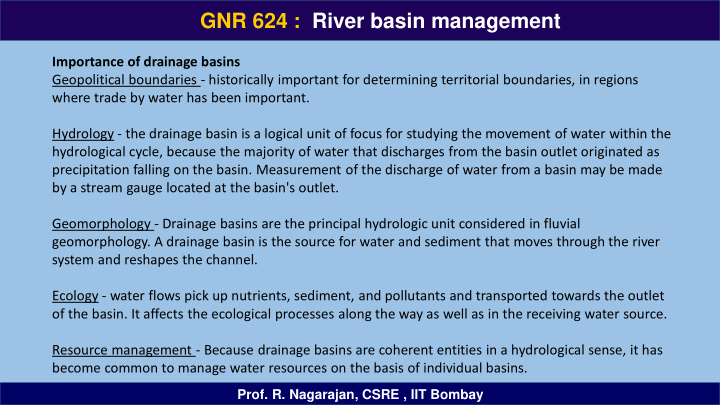



GNR 639 GNR 624 : River basin management Importance of drainage basins Geopolitical boundaries - historically important for determining territorial boundaries, in regions where trade by water has been important. Hydrology - the drainage basin is a logical unit of focus for studying the movement of water within the hydrological cycle, because the majority of water that discharges from the basin outlet originated as precipitation falling on the basin. Measurement of the discharge of water from a basin may be made by a stream gauge located at the basin's outlet. Geomorphology - Drainage basins are the principal hydrologic unit considered in fluvial geomorphology. A drainage basin is the source for water and sediment that moves through the river system and reshapes the channel. Ecology - water flows pick up nutrients, sediment, and pollutants and transported towards the outlet of the basin. It affects the ecological processes along the way as well as in the receiving water source. Resource management - Because drainage basins are coherent entities in a hydrological sense, it has become common to manage water resources on the basis of individual basins. Prof. R. Nagarajan, CSRE , IIT Bombay
GNR 639 GNR 624 : Water Resource and River basin management Drainage basin is an extent or an area of land where surface water from rain, melting snow, or ice converges to a single point at a lower elevation, usually the exit of the basin, where the waters join another waterbody, such as a river, lake, reservoir, estuary, wetland, sea, or ocean. River basin is used to describe an area that drains Into larger river/ocean. Larger rivers are interconnected watersheds. Watershed describe an area that drains into a Smaller river or stream. Prof. R. Nagarajan, CSRE , IIT Bombay
GNR 639 GNR 624 : Water Resource and River basin management Prof. R. Nagarajan, CSRE , IIT Bombay
River basin components Catchment area Command area Coastal area Issues in river basin Rainfall & water availability Storage & distribution Sharing in space & time – quantity & quality
GNR 639 GNR 624 : Water Resource and River basin management Prof. R. Nagarajan, CSRE , IIT Bombay
Factors influencing river basin system • Size • Shape • Physiography • Climate • Drainage • Land use • Vegetation • Geology and Soils • Hydrology • Hydrogeology • Socioeconomics 10.1
GNR 639 GNR 624 : Water Resource and River basin management River Basin structure Components of river basin Catchment area Utilization area – command area Coastal area Issues in river basin Rainfall & water availability Storage & distribution Sharing in space & time – quantity & quality Prof. R. Nagarajan, CSRE , IIT Bombay
GNR 639 GNR 624 : Water Resource and River basin management Prof. R. Nagarajan, CSRE , IIT Bombay
River types Perennial river – flow throughout the year • Permanent rivers • Exotic rivers Non-Perennial rivers – flow in rainy seasons • Periodic rivers • Episodic river Channel types Source courtesy: acegeography.com • Straight channel • Braided channel numerous distinct channels that repeatedly divide and then merge again downstream • Meander channel consists of single main channel that bends and loops
Recommend
More recommend